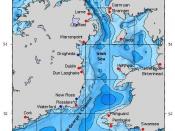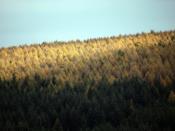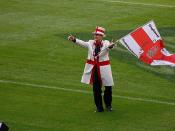England is an island east of Wales and south of Scotland. It has been an independent monarchy for many centuries. The capital, largest city, and chief port of England is London, with a population in 1996 of 7 million. It is also the capital of the United Kingdom and the site of the headquarters of the Commonwealth of Nations.
England is triangular in shape. The eastern part is located by the North Sea The western part of the triangle extends southwest from the mouth of the Tweed River along Scotland, the Irish Sea, St. George's Channel, and the Atlantic Ocean to Land's End. The northern part extends from Solway on the west along the Cheviot Hills. The base of the triangle is in front of the English Channel. The total area of England is 130,410 square kilometer (50,350 square mile).
England has some agricultural and mineral resources but must rely on imports.
Approximately two-fifths of the land area is farmable, with the richest soils found in the east. Large reserves of iron are in Cumbria, Staffordshire, and Lancashire. Waterpower resources are small and are mostly in the highlands of Cumbria.
In early times, England was heavily forested, mainly with oak and beech in the lowlands and pine and birch in the mountainous areas. Woodlands are now about 8 percent of the total land area. Various types of fruit tree are in the forests, including the cherry, apple, and plum trees. Numerous varieties of wildflowers are also found. Besides all of this land, England has a lot of animals that have lived on this land for many years. There are several species of deer, fox, rabbit, hare, and badger. The most seen birds are the meadow pipit, and the sparrow. Other known species are the crow, pigeon, rook, and the...


